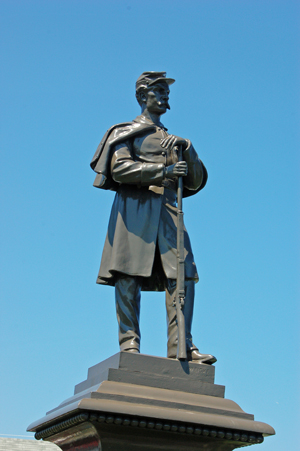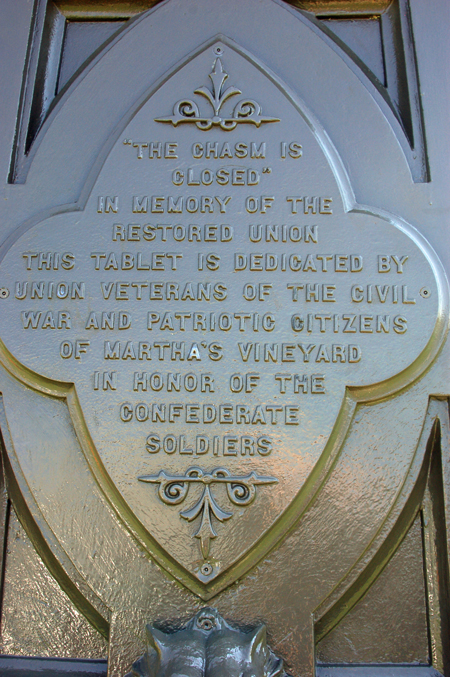
When you disembark from the ferry into the Martha's Vineyard Island town of Oak Bluffs, this watchful life-size Civil War soldier on a pedestal stands directly ahead on the grass. He doesn't seem out of place; after all town is famous for its quaint Victorian-era gingerbread cottages. It's not at all odd that it would have a Civil War monument. Massachusetts sent almost 150000 men to fight the secessionist states of the Confederacy; nearly ten percent of those never came home.

But the meaning of the statue becomes a lot more murky if you actually read the plaque on the monument:
In memory of the restored Union this tablet is dedicated by
Union veterans of the Civil War and patriotic citizens of Martha's Vineyard
in honor of the Confederate soldiers
Whaa? What's a monument to Confederate dead doing on the green in Oak Bluffs?
Apparently it is a relic of a conservative political movement in the late 19th century that sought to "look forward, not backward" -- to re-remember the Civil War as some kind of huge national mistake that killed heroic brothers, to erase the reality that the war was fought to end slavery. That is, when we see this monument and its inscription, it is as if we're meeting a kind of "Fox News" from the 1890s, distorting reality for the benefit of the powerful, all preserved in heroic cast iron.
But I was stunned to read this sentence as the lead in one article:
The Civil War started in 1861, when President Abraham Lincoln signed the Emancipation Proclamation into law ...Yikes -- where was this child's history teacher? Emancipation didn't come until two years into the Civil War, until 1863, by which time the murderous conflict had become a clear cut fight over whether the system of slave labor would survive or die. The story of our defining intramural war is emblematic of the country's lurching path toward broader human freedom. A child doesn't have to know or understand about all that, but it is up to her teachers to help her get the basic chronology right.
The student writer also enthused about the monument. Okay, I can imagine she needed a topic and a quick essay to finish a homework assignment. But some teacher ought to have offered some perspective on this very contentious subject. We do students no favor by glossing over our history, its shame as well as its accomplishments.
UPDATE: See the comment from Bruce Nevin below. Looks like I got this wrong.
It's actually a Union soldier. To create and erect it was the project of Charles Strahan, editor of a now long defunct local newspaper. He was a Confederate veteran who had come to the Island from Richmond, Virginia, where he had also been a newspaper editor. It took him many years to raise the money and accomplish this gesture of peace, and the plinth was blank until the 1930s because of recalcitrant opposition from Union veterans. Look at the plaque on the other side of the base for the story. A description, with pictures, by a descendant, is at https://thetompostpile.wordpress.com/2012/10/09/charlies-statue/
ReplyDeleteI don't remember seeing the statue when I visited the island, but maybe it's because I took a different ferry. I probably came over into Vineyard Haven terminal, but I did go visit Oak Bluffs a number of years ago. I guess people are still talking about it.
ReplyDeleteMartha’s Vineyard Confederate Statue Throws Shade On Obama’s Vacation - http://conservativefrontline.com/marthas-vineyard-confederate-statue-throws-shade-on-obamas-vacation/
I visited Martha's Vineyard this summer. I was surprised by the inscriptions on the monument and were pleased by what was stated and the intentions that went with the monument.
ReplyDeleteThe original man erected the monument with the union soldier. The plaque below it read "Erected in honor of The Grand Army of the Republic by Charles Strahan CO. B 21st VIRGINIA REGIMENT".
That soldier, Charles Strahan, was honoring the soldiers that he helped fight against. In response many of the Union soldiers and descendants rededicated the monument "in honor of the confederate soldiers". They did not praise the Confederacy or slavery. They honored the courage and sacrifice that confederate soldiers made.
While the Civil War was vicious and bloody, it was fought by men who largely acted honorably (e.g. avoiding killing civilians).
Some people only look at the Civil War through the issue of slavery. When they do that they really do not see but a part of the history. They also do not see the respect that the individual soldiers had for each other.
Note that the inscription stated "The chasm is closed". They meant that we are one country now. We all should act like loyal Americans. Listen to one another. Love each other. Stop holding grudges.
When are you going to start?
Sorry Steve -- the Civil War was first, foremost and always about whether the South could keep slavery. Listen to Alexander Stephens, Vice President of the Confederate States of America: "Our new government is founded upon exactly the opposite idea; its foundations are laid, its corner-stone rests upon the great truth, that the negro is not equal to the white man; that slavery -- subordination to the superior race -- is his natural and normal condition."
ReplyDeleteI find that pretty conclusive and the fact that a lot of people want to deny it makes it all the more important to call out monuments (and the Battle Flag) that are used to suggest it was about anything else.
"Historical travesty?" The only historical travesty is the Marxist historical revisionism taking place in this country at the hands of the racists in Blacklivesonly and the morons who support them.
ReplyDeleteRecently I arrived back in the States after a conference in Brazil. Home was in a hubbub about Charlottesville, Virginia. The initial issue was the removal of a statue of Robert E. Lee from a city park. Neo-Confederates, Neo-Nazis and Klansmen descended on the college town in a bravura celebration of white supremacy. Civil Rights advocates, Black Lives Matter and the antifascist group Antifa opposed them. A clash occurred and a white supremacist rammed his car into a crowd of protestors, killing one young woman and injuring scores. President Trump made matters worse when he commented on the events, asserting that there were "good people on both sides." A loud chorus pf American informed him that there are no good Neo-Nazis and white supremacists. The ripples of the president‘s remarks still reverberate in our ongoing debate about “Race”. The summer of 2017 has been marked by the removal, sometimes grudging, of statues to the "Lost Cause" throughout Dixie. Some see taking down the statutes as the first step to dealing with slavery. Others dismiss debates over memorials as purely symbolic acts; certainly they won't stop police brutality or lessen the massive rate of black incarceration. And, some argue, wasn't Washington just as much of a white nationalist as Lee (although with a bigger monument)? In the current brouhaha, slavery, racism, white nationalism and a faltering Trump presidency combine to create an inchoate debate. But the issue should be clear, even through the clouds of tear gas that have been dispersed and will be dispersed. The United States is in an existential quandary; who won the Civil War, who should have won?
ReplyDeleteIt is indeed a travesty.
ReplyDeleteRecently I arrived back in the States after a conference in Brazil. Home was in a hubbub about Charlottesville, Virginia. The initial issue was the removal of a statue of Robert E. Lee from a city park. Neo-Confederates, Neo-Nazis and Klansmen descended on the college town in a bravura celebration of white supremacy. Civil Rights advocates, Black Lives Matter and the antifascist group Antifa opposed them. A clash occurred and a white supremacist rammed his car into a crowd of protestors, killing one young woman and injuring scores. President Trump made matters worse when he commented on the events, asserting that there were "good people on both sides." A loud chorus pf American informed him that there are no good Neo-Nazis and white supremacists. The ripples of the president‘s remarks still reverberate in our ongoing debate about “Race”. The summer of 2017 has been marked by the removal, sometimes grudging, of statues to the "Lost Cause" throughout Dixie. Some see taking down the statutes as the first step to dealing with slavery. Others dismiss debates over memorials as purely symbolic acts; certainly they won't stop police brutality or lessen the massive rate of black incarceration. And, some argue, wasn't Washington just as much of a white nationalist as Lee (although with a bigger monument)? In the current brouhaha, slavery, racism, white nationalism and a faltering Trump presidency combine to create an inchoate debate. But the issue should be clear, even through the clouds of tear gas that have been dispersed and will be dispersed. The United States is in an existential quandary; who won the Civil War, who should have won?
ReplyDelete